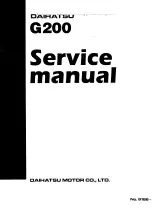
Maintenance and do-it-yourself
7-25
of whether it has been used or
not.
Tires degrade with age as well as
the use they are subjected to,
have your tires checked and
balanced
frequently
by
a
recognized tire agent. Report all
accidents where the tire is
knocked however minor.
Changing tires and wheels
When replacing a tire, use the
same size, speed rating and load
carrying capacity as originally
equipped. Recommended types
and sizes are s
hown in “Wheels
and tires” in the “Technical
information” section. The use of
tires
other
than
those
recommended or the mixed use of
tires
of
different
brands,
construction (bias, bias-belted or
radial), or tread patterns can
adversely affect the ride, braking,
handling,
ground
clearance,
body-to-tire
clearance,
snow
chain clearance, speedometer
calibration, headlight aim and
bumper height. Some of these
effects may lead to accidents and
could result in serious personal
injury.
If the wheels are changed for any
reason,
always
replace
with
wheels which have the same
offset dimension. Wheels of a
different offset could cause early
tire wear, possibly degraded
vehicle handling characteristics
and/or interference with the brake
discs/drums. Such interference
can lead to decreased braking
efficiency and/or early brake
pad/shoe wear.
WARNING
Do not install a deformed wheel
or tire even if it has been
repaired. Such wheels or tires
could have structural damage
and could fail without warning.
CAUTION
●
Always use tires of the
same size, brand, construction
(bias, bias-belted or radial), and
tread pattern on all four wheels.
Failure to do so may result in a
circumference
difference
between tires on the front and
rear axles which will cause
excessive tire wear and may
damage
the
transmission,
transfer case and differential
gears.
●
ONLY
use
spare
tires
specified for each 4-wheel drive
model.
Wheel balance
Unbalanced wheels may affect
vehicle handling and tire life. Even
with regular use, wheels can get
out of balance. Therefore, they
should be balanced as required.
















































